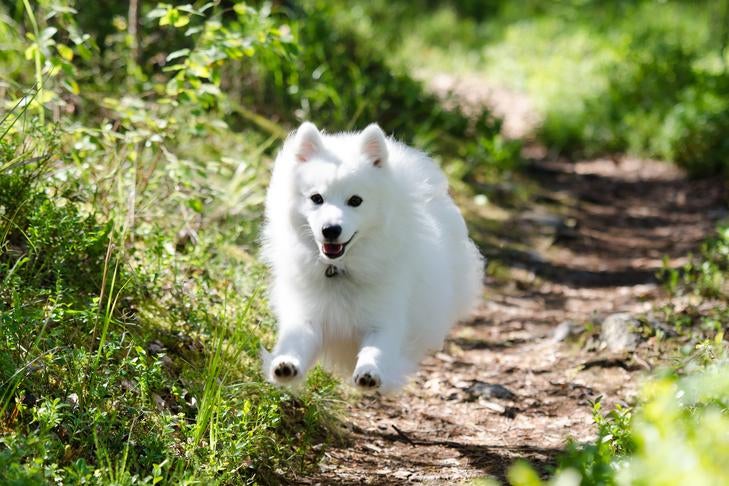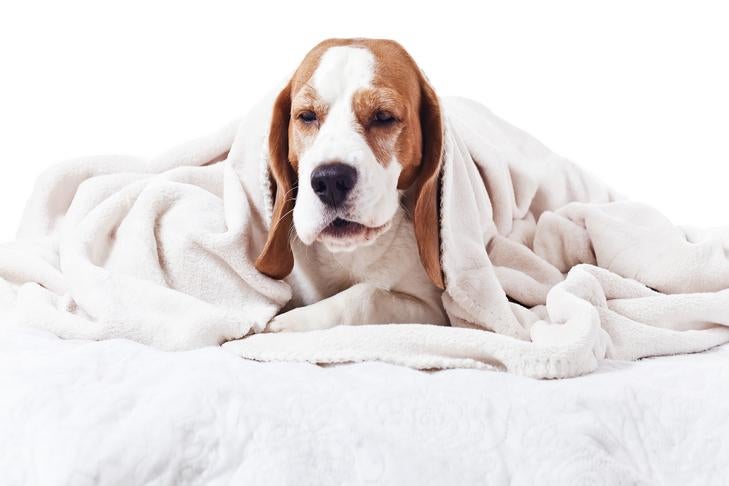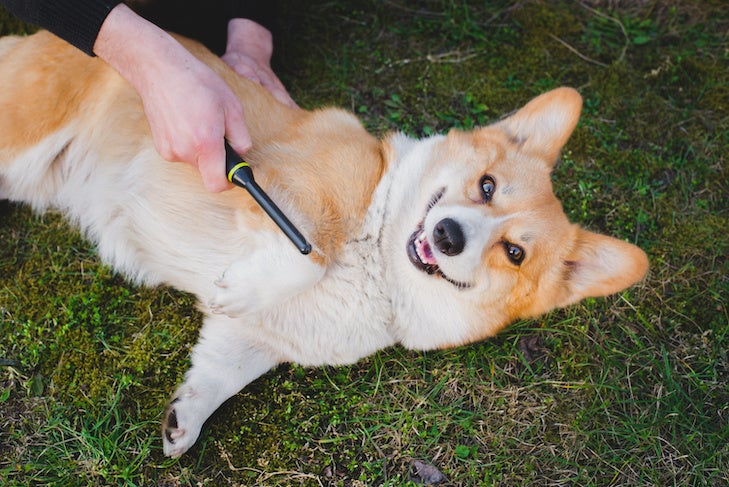Sweaters and pumpkins aren’t the only ones making a return in the fall. That noticeable chill in the air happens to coincide with when plants and trees are starting to shed their seeds. These prickly seeds, known as burrs or stickers, can latch on and become entangled in your dog’s fur. If left untreated, burrs can cause irritation, pain, and infection. Here’s what you need to know to get through the season with your dog and how to get burrs out of dog fur.
What Are Burrs?
Burrs are seed pods that have teeth or hooks that can grab onto hair or clothing. “They’re like the strongest Velcro you can imagine,” says Dr. Amy Attas, VMD. “Burrs typically come at the end of the growing season when plants are drying out and shedding their seeds, so they can move someplace else to germinate and grow,” she notes. When your dog runs through a hiking trail or simply brushes against an area with weeds and grass, their coat can become a magnet for burrs.
Which Breeds Are Most Likely to Get Burrs?
All dogs can get burrs, but they tend to be less of a concern for short-coated dogs like the Beagle, Bulldog, or Boxer. For dogs with a longer coat or a dense undercoat, burrs are more likely to get entangled in their fur, which can be very painful, Dr. Attas explains. The teeth on burrs are sharp enough to make little cuts, which can irritate the skin and become infected.

Where Should You Look for Burrs?
Burrs can get stuck anywhere, but where they really cause problems is when they attach to your dog’s butt, underneath their armpit, tail, or earflap, or in between their toes, Dr. Attas says. “Those are places where dogs don’t like to be touched and now there’s something pinching into their skin, and you have to get it out,” she explains.
Spotting burrs on the feet is especially tough because of the fur and tight spaces between their toes. For instance, you might see an inflamed foot without even knowing that burrs are the culprit. If this happens to your dog, you can try soaking their paw and gently feeling around for areas that are particularly sore or swollen. “Oftentimes, burrs on the feet need to be removed at the vet’s office under mild sedation because they’re very painful,” Dr. Attas says.
What Happens If Your Dog Swallows a Burr?
Another risk is that your dog might swallow or inhale them a burr. For some dogs, ingesting a burr requires veterinary intervention; in others, burrs don’t cause much of an issue. In the latter case, your dog might simply have successfully swallowed the burr or the contents of their stomach might form a coating around the sharpness of the burr, allowing it to pass naturally.

If you see your dog swallow a burr, keep a close eye on them to make sure they’re eating and drinking normally. Signs of trouble include coughing, difficulty breathing, or excessive drooling. There’s no need to intervene unless your dog is having trouble eating or eliminating.
What Do You Need to Remove Burrs?
If you live in an environment where burrs are abundant or if your dog has gotten them before, Dr. Attas recommends having a toolkit on hand to safely remove burrs. Here are the supplies you’ll need:
- Gloves to protect your hands
- A wide-toothed metal comb
- A pair of pliers
- Dog treats
- A can of cooking spray
Optional
- Someone to help you
- An electric shaver
If possible, it’s a good idea to have someone assisting you. A helper can have a secure hold on your dog. That both keeps your dog still, while it “is also comforting for them to be held like that,” Dr. Attas adds. You also want to have delicious dog treats on hand as a reward for remaining calm.
How Do You Remove Burrs?
Once you have your gloves on, see which burrs look the least entangled and start with those. If you see a large burr, Dr. Attas recommends using pliers to crush the burr because it’s easier to get the smaller pieces out first. Then, try to gently tease the fur away from the burr, keeping your hand between the skin and the burr so it can’t fall over and get reattached.
If your dog has a very dense coat, you can spray some cooking oil on their fur. This will act like a lubricant to help you separate the hair from the burr. Cooking spray is a good option because once you’ve removed the burr, your dog will want to lick everything and it’s better if they ingest a little canola oil rather than a product that’s full of chemicals. As you’re pulling out pieces of burr, you can use the wide-toothed comb to get between the skin and fur. Gently comb out small bits at a time. Similar to when you’re trying to detangle your own hair, make sure to comb away from the root to avoid pulling at your dog’s skin.

If you can’t get a comb between their skin and the burr, “don’t reach for the scissors because it is so easy to cut their skin,” Dr. Attas emphasizes. “The only time you can use scissors for cutting your dog’s fur is when you can see light between the skin and the part you want to cut out.” Instead of scissors, it’s better to use an electric shaver to protect their skin from being cut. Since dogs can be sensitive to sound and vibrations, start by turning on the shaver and speaking to your dog in a soothing voice. Reassure your dog there’s nothing to worry about and reward them with a treat.
Next, with the shaver on, place the end without the blade on different parts of your dog’s body so they can get used to the vibrations. Keep speaking to them calmly and giving them treats. As you get closer to the area where you need to work, start by shaving off a little bit of fur at a time. Depending on how close the burr is to the skin, you might be able to leave behind a layer of fur, or you might need to shave the area like a surgical shave. If you have any concerns about removing burrs at home, you can make an appointment with your veterinarian or groomer.
How Do You Prevent Your Dog from Getting Burrs?
Some hunters who have their dogs outside all the time apply hair detangler to their dog’s coat, which can cut down on burrs. “The best thing you can do is keep your dog well-brushed and well-groomed, especially when you come in from a walk in a wooded area,” Dr. Attas explains. It’s unlikely for burrs to make their way to the skin if your dog is well-groomed.
Problems with burrs are more common in dogs with matted hair or if they try to scratch burrs out themselves. “If you do a good job of grooming on a daily basis, dogs are less likely to have trouble with burrs,” Dr. Attas says. “They’ll still get them, but they won’t be a big deal.”
This article is intended solely as general guidance, and does not constitute health or other professional advice. Individual situations and applicable laws vary by jurisdiction, and you are encouraged to obtain appropriate advice from qualified professionals in the applicable jurisdictions. We make no representations or warranties concerning any course of action taken by any person following or otherwise using the information offered or provided in this article, including any such information associated with and provided in connection with third-party products, and we will not be liable for any direct, indirect, consequential, special, exemplary or other damages that may result, including but not limited to economic loss, injury, illness or death.

